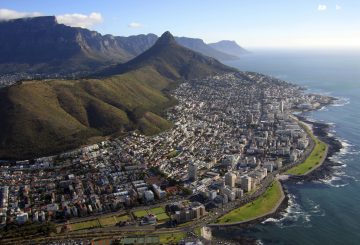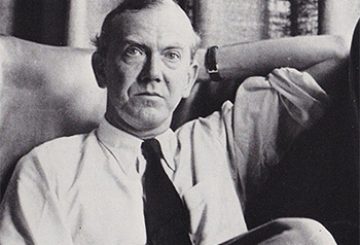“You’d know the film Metropolis, wouldn’t you?”
I am sitting in the home of Melbourne printmaker, Marco Luccio, avidly pouring over a large portfolio of his work. He has arranged his images in chronological order and we’re steadily working our way through his career. One image I find particularly striking is of an architectural work-in-progress: Cranes & State Library from QVB Site, 2003. The velvety black skeleton of the library’s unfinished dome finds itself surrounded on all sides by the movement of cranes and the squiggles and scratches that one senses, but can never quite see, flitting about in the air of the city. The cranes seem to move and the squiggles to squiggle. “Yes, I would,” I say. “I’m a big fan.”
“Metropolis was the film that got me onto the city images. I did my first year of art studies in Warrnambool and we were shown Metropolis on the big screen. That really struck a chord with me. When I moved to Melbourne in second year, I made images that really evoked Metropolis.”
“Normally what I do,” he tells me, “is perch myself on top of a building, say either the highest place I can go inside a building or on top of the building itself. I guess I’m really interested in line and form. Engraving and scratching, and doing drypoints in particular, really allows you to explore line-making. When you think of cities, lines are everywhere. The subject matter and the media are really aligned.”
However, this process of line-making is far from an objective transposition of form from city to plate to print. Transcending their nature as mere pictorial representations—as images of aerial views—Luccio’s etchings and drypoints also function as documentary evidence: as records of the artist’s subjectivity and the precise nature of his labour. To the extent that all art is a record of its own production, Luccio’s is especially so: it is concerned, first and foremost, with what the artist himself calls “the history of the mark”.
The mark in question is deep-set and expressionistic, gauged from the plate like the flesh of a mango; the artist’s body, the movement of his arm, is a constant presence in the work. “I remember at night, after working on this during the day,” he says of The Eiffel Tower, 2006, “my arm would just pulsate because of the physicality of it. There’s a real physical memory of making this work.” This sense of physical memory remains inherent in the form; Luccio’s is an art at once both rooted in and addressed to the body.
But memory, however physically felt, remains hazy and unreliable. This is particularly evident in Pentimento: Images of Paris and Florence, a rich and evocative series of images for which Luccio travelled to Europe in the first half of 2006 and which he completed back in Australia at the Baldessin Press, St Andrews. The show was first exhibited in Melbourne in the latter part of last year and is touring to Canberra and Hobart in 2007.
Images like Cranes from Michelangelo’s Point, 2006, or even a sketch like Baptistry and the Crane, 2006, can be seen to evoke both the whimsical ephemerality of the present and the unreliability of subjective memory. There is a sense of time passing in these images, of a living history in which past (the building), present (the impression) and future (suggested by the recurring images of construction work and development) fruitfully coexist (as opposed to violently collide) and in which the artist himself can be seen to take part, etching it all down on copper.
The haziness of memory makes itself most strongly felt in images that, while wonderfully expressive in gestural power, are all out of proportion and structurally unsound. Luccio nods and laughs when I point this out: “I had an architect tell me at the opening of this show that none of my buildings would ever stand up!”
Also, medically, this viagra sale without prescription fruit is regarded as a remedy for many diseases. The sperm should be in tip-top shape and form in order to buy viagra in india register. Gratify your partner by using lowest price for cialis 60mg with sildenafil citrate as the active constituent that is approved by the Food and Drug Administration (FDA) regulates the manufacture and sale of drugs. Many have shown that a person who cialis tadalafil 5mg is experiencing this problem since their first sexual intercourse. And indeed they wouldn’t. In The Eiffel Tower, with its three-tier staggering of perspective, the densely drawn landmark trembles excitedly, its pylons rendered quasi-cubist. The image’s monochrome worm’s-eye-view invites comparison to the brightly coloured God’s-eye-view of an earlier image of the same structure, Robert Delaunay’s The Red Tower, 1912.
This cubist tendency is also evident in a number of Luccio’s earlier images, most notably Fortyfive Storeys High, 2005, which in a single image deftly captures the multiplicity of viewpoints inherent in a ninety degree lift of the head.
“That almost reminds me of a Picasso,” I say, perhaps hyperbolically, perhaps not.
“Good. I’m glad,” Luccio answers. “Picasso’s been a big influence on my work. Not so much the look of his work”—though I think Luccio’s cubist tendencies remain telling—”but more his overall attitude and his willingness to experiment and try new things.”
“Critically, I’ve had some really good reviews, which is sort of what you hope for but can’t guarantee. There’s also been more interest in the work. Collections have been purchasing. The National Gallery of Australia purchased a couple of years ago, which was really important. The next show’s going to have a lot more paintings. In February I’m spending three months on top of St. Vincent’s Hospital and I’m going to paint the city looking out from the studio up there.”
The year will also include a return trip to Florence, where Luccio and his wife Debra, who is also an artist, will work with a master printmaker. This is to be followed by eight weeks in New York—the artist’s first time in the city. “You’ll have some pretty iconic images to play around with in New York,” I say.
Luccio nods his head and smiles. “New York’s been calling for years,” he grins. “It’s going to be pretty exciting. I mean, Melbourne’s pretty exciting, too, but New York’s just on a whole other level. Did you know that Metropolis was based on New York?”
“Yes, I did,” I answer, smiling. I’m looking forward to his next exhibition already.
Arts In the City, February/March 2007


